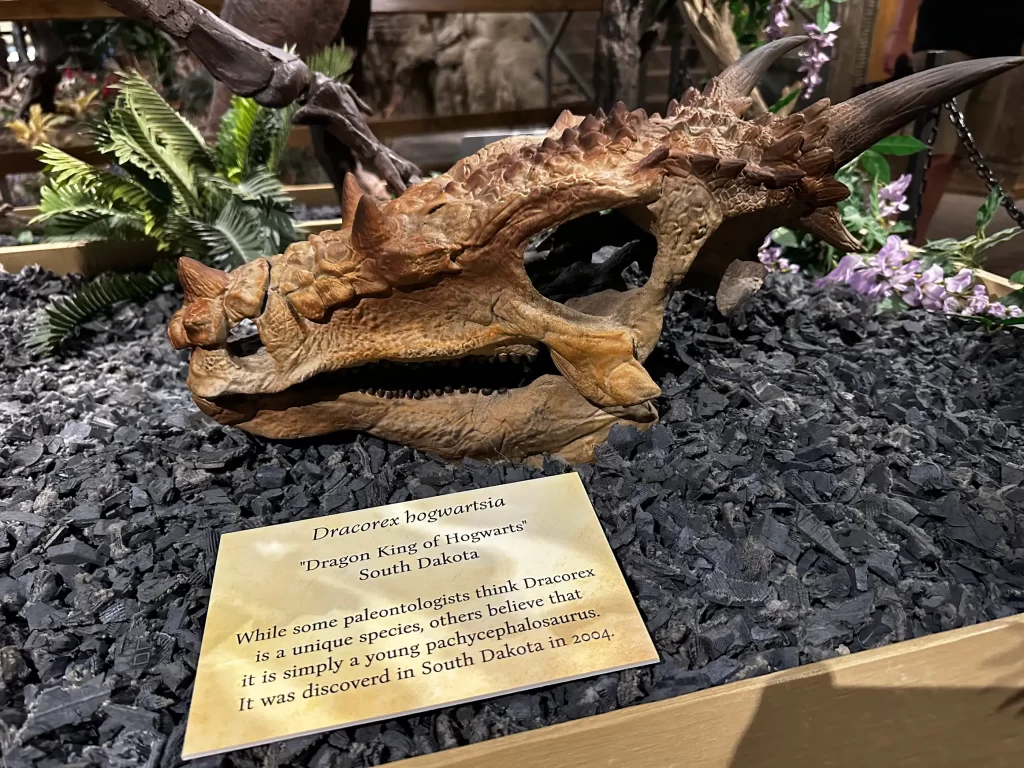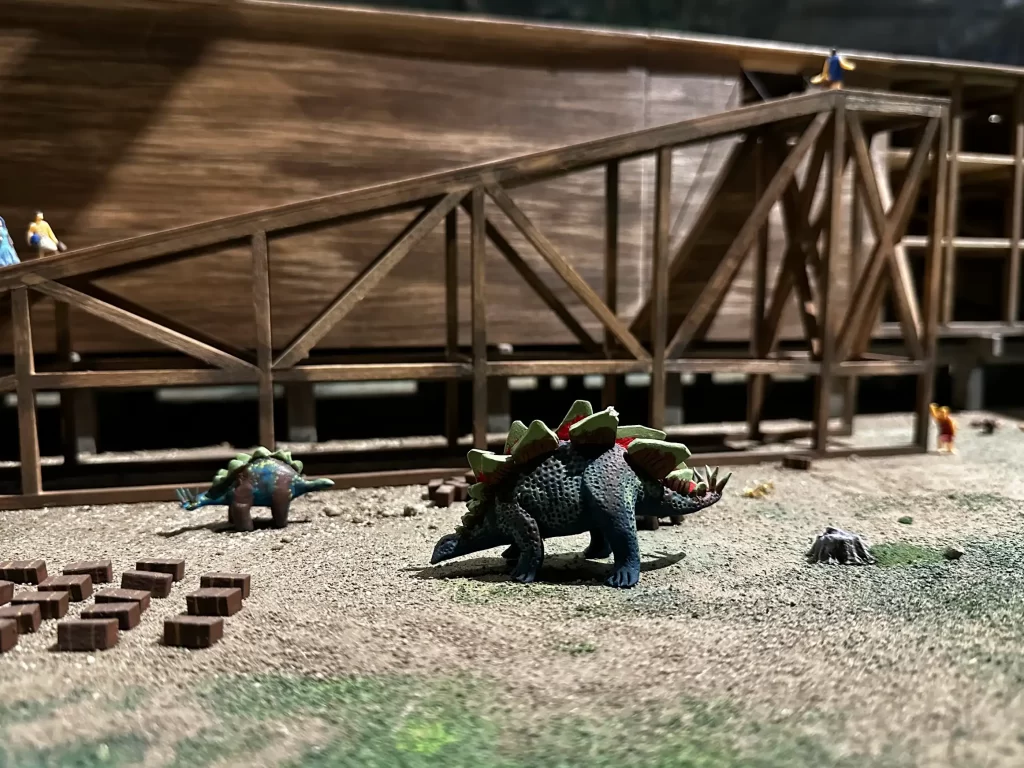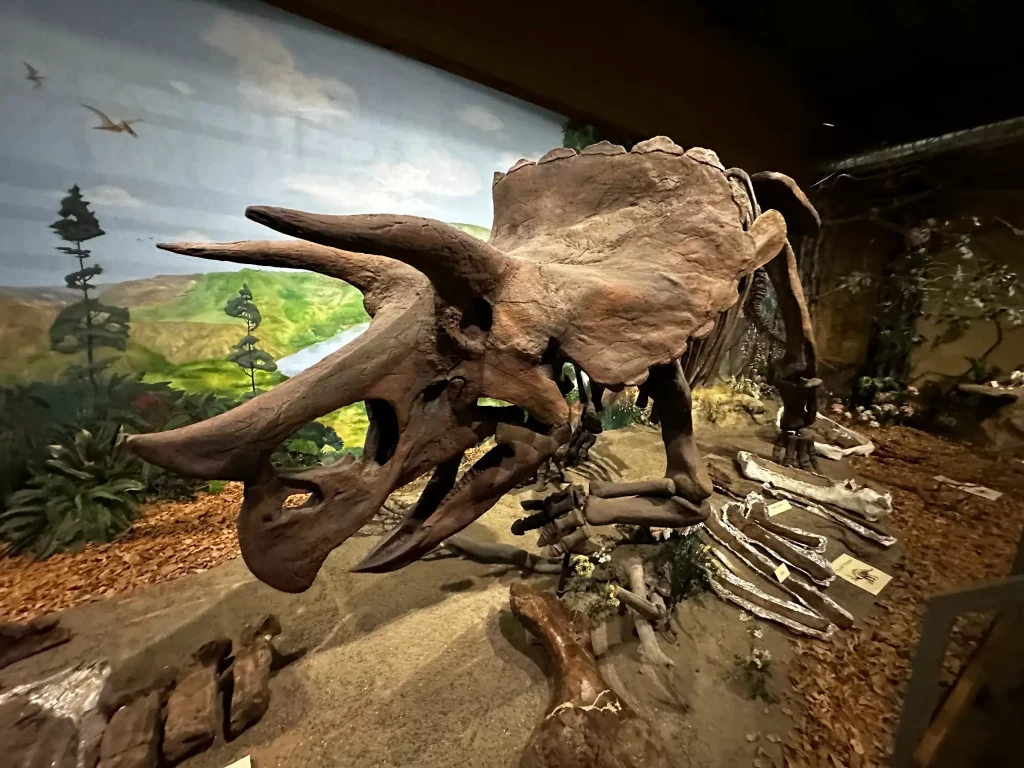As noted on the museum’s website, the Glendive Dinosaur and Fossil Museum, presents its exhibits in the context of biblical history.

Glendive, Montana — As I began Phase Two of my John Steinbeck Travels with Charley tour of America, I determined to pay a visit — for the fifth time — to the Dinosaur and Fossil Museum in Glendive, Montana (population 4,811).
The museum gets 8-10,000 visitors per year. It is closed during the long eastern Montana winter (November through April).
According to a 2019 Gallop poll, four in 10 Americans (40%) believe that God created human beings in more or less their present form less than 10,000 years ago. If that is accurate, approximately 136 million Americans subscribe (in varying degrees of certitude) to the Young Earth Creationism theory. I’m pretty sure the number is not nearly that high and that the Gallop poll is really measuring three things:
- Deep skepticism about evolution.
- A rejection of the notion that humans evolved from other primates.
- A firm conviction that the Judeo-Christian God is the Author of the Universe.

The Glendive Museum’s approach is something called Creation Science. Under this formulation, it was God alone who created the universe. The universe is not random. It didn’t just happen. If there was a Big Bang, God set it off. God willed the universe into being from nothing (ab nihilo, as St. Augustine put it). The creation didn’t happen 13 billion years ago, but only yesterday, six to 10,000 years ago. God did his creative work in a calendar week, just as Genesis explains. His masterwork — “the beauty of the world, the paragon of animals,” as Shakespeare puts it — was man (humankind). We humans were never apes or any other primate. We were created as a distinct terminal species with no evolutionary upgrades. We did not evolve from something more primitive into our present form.
According to the creationists, the “theory of evolution” is only that, a theory, and it is riddled with errors, inconsistencies, profound gaps, and false assumptions. The museum bookstore sells books that “prove” that evolution doesn’t hold up even to rigorous scientific scrutiny, much less Christian faith and theology. I purchased one of the books, Evolution’s Achilles Heels: Ph.D. Scientists Explain Evolution’s Fatal Flaws — In Areas Claimed to be its Greatest Strengths.
Ok.
So Why Visit?
If 40% of the American people believe that God created the world in seven calendar days less than 10,000 years ago, I think it’s important to try to understand their perspective. America is their country as much as it is mine and yours, and frankly, the creationists are more in harmony with the worldview of most pre-Enlightenment scientists, philosophers, and theologians of Western civilization than I am. I subscribe to the principles of the Enlightenment: the free marketplace of ideas, the complete and uncompromised right of a free people to hold any views they wish, so long as they don’t try to force the rest of us to agree or comply. As my hero, Thomas Jefferson wrote to his grandson Thomas Mann Randolph on November 24, 1808, “When I hear another express an opinion, which is not mine, I say to myself, he has a right to his opinion, as I to mine; why should I question it. His error does me no injury, and shall I become a Don Quixote to bring all men by force of argument to one opinion?”
I could not agree more.
Besides, just because other people hold views that I regard as palpably irrational and unscientific, that alone does not mean they are not worth knowing for many other good reasons. One of my old friends subscribes to the system known as British Israelism, which argues that the British are the chosen people of God and the Semitic people are not. That seems like a whopper to me and probably antisemitic, but if we are talking about our shared love of the Bitterroot Mountains or Pinot Noir, we get along just fine. I know many people who see the world in ways that I regard as absurd — and I’m guessing they feel the same way about me. So long as everyone agrees to restrict their religious views to private life and their private voluntary associations, and no attempt is made to intrude those views into the arena of public policy, their errors do me no injury as mine do not injure them.
How can you make sense of America if you don’t try to understand the millions of people who don’t see things as you and your cohort do? It’s a vast and diverse country, America, and as Walt Whitman said, it contains multitudes. If the creationists only numbered a few hundred thousand, I probably wouldn’t bother to try to understand. But 40%? You cannot ignore half of the country we share.
How to Visit the Fossil and Dinosaur Museum

You can carry a number of distinct attitudes through the doors of the Glendive Fossil and Dinosaur Museum.
1. You can go as a scoffer and call your friends over to snicker at the large model of Noah’s Ark, where dinosaurs are lining up to walk up the ramp into safety as the flood waters rise. If you regard the Young Earth theory as irrational and, in fact, moronic, you will find plenty to ridicule in the museum.
2. You can visit as a true believer, a biblical literalist, and a Young Earth advocate. If so, you’ll be provided a range of arguments and “proof” that God created the universe about 6,000 years ago. On other occasions, I have seen home school parents leading their young children from exhibit to exhibit and insisting that they are in an encounter with the truth for a change, not the lies espoused by secular humanists and the American public school system.
3. You can enter with an open mind, curious, and quite willing to be convinced if the evidence is convincing.
4. You can walk in sure that the basic premise of the museum is nonsense, but wanting to know how such people think.
5. Or you can go in pretty sure the Young Earth thesis is nonsense but nevertheless eager to see an impressive display of genuine fossils, dinosaur casts, dioramas, and a display of real and facsimile books, scrolls, and documents in the separate Bible Room, including an authentic 1611 King James translation of the Bible (in folio). (It’s worth a trip to the museum to see the King James folio, as it would be worth going into a Francis Bacon or Earl of Oxford museum to view the First Folio of Shakespeare. In other words, no matter what your view of creation or evolution, the Glendive Museum is a great place to see a Plesiosaur, a Triceratops, and a Tyrannosaurus Rex. They take their work very seriously.

My first visits 15 years ago were best characterized by #1, but more recently, I have been motivated by #4 and #5. The paleontologists associated with the Glendive Museum are out digging in the shales of several western states every summer, using the best approved paleontological methods. The museum staff members and docents I have encountered are respectful, thoughtful, and wholly earnest but firm in their views.
I cannot say that my mind is open to their point of view. In other words, I cannot imagine that if I were exposed to every bit of their “evidence,” if I read all of the creationist and anti-evolution literature at full attention and willing to be convinced, and if I tried to read the Book of Genesis as infallible scientific truth about a seven-day creation of the world, that I could be convinced.
The medieval principle of Occam’s Razor applies here. Occam’s Razor: the most straightforward and logical explanation is almost certainly correct. What is more likely, that there were a pair of Triceratops on Noah’s Ark, or that the dinosaurs had been extinct for tens of millions of years before Noah was born (if he existed at all)? What is more likely, that the Grand Canyon’s more than 40 distinct geological layers were laid down in one catastrophic flood (ca. 2300 BCE), or that there are literally 1.84 billion years of geomorphic activity on display there? What is more likely, that Noah was 600 years old when he built the Ark, or that he was perhaps 60 or the biblical threescore and 10? What is more likely that the entire Earth was covered with no less than 15 cubits (22 feet) of flood water, inundating Mount Everest at 29,032 feet above sea level, or that the Tigris and Euphrates Valley suffered a catastrophic flood that seemed to wipe out the whole (then known) world? What is more likely, that the chain of DNA evidence is mere coincidence or that all creatures, all species, are the result of millions, even billions, of years of evolutionary development?

But if you are a biblical super-literalist and believe that everything that is included in the Bible is the inerrant Word of an omnipotent and omniscient God, and you conclude, therefore, that the creation stories in Genesis must be literally true (including the timeline), then you have to squeeze and shape all that evolutionary and geological evidence into a very constricted framework. Since the Enlightenment (1680-1826) most historians, biblical scholars, theologians, and mainline Christian pastors have viewed the Genesis accounts as “poetic,” “metaphoric,” “fabulistic,” or “mythological” (in the most positive sense), and they no longer believe in a six or seven day creation, unless “day” is regarded as epoch and Methuselah’s 969 years were, well, exaggerated. Even then, from a modern scientific point of view, the Genesis accounts are essentially non-sensical because the creative sequence could not have unfolded in that way, even over eons.
As they say, the Book of Genesis is not a scientific textbook or a scientific tract.
Dialogue
When I visited the museum the other day, it was nearly empty, so a staff member named Chuck H. approached me to ask if I had any questions.
I did have questions.
My purpose wasn’t to trip him up but to understand the logic of creationism. I did not play Clarence Darrow and ask him how Jonah managed to stay alive for three days in the whale; how the Earth survived when the sun stood still in the heavens for more than a day; where Cain found a wife; or whether Adam and Eve had belly buttons.

I asked my guide if he regards the Bible as the authentic and unerring Word of God. He said yes. I asked him if the Old Testament’s account(s) of creation are literally (not metaphorically) true. He said yes. I asked him if he had any doubts about his or the museum’s assertions. He said no.
I asked: if the dinosaurs were on Noah’s Ark, as the museum insists, why did they go extinct after the flood waters receded? Chuck answered that the Earth’s climate had changed during the flood, and the dinosaurs were unable to find suitable habitat after that. He explained that some dinosaur species blinked out; others bred down to smaller sizes to accommodate the new conditions. Turning to the extremely impressive cast of the Tyrannosaurus Rex that loomed over most of the museum floor, he said the T-Rex were simply too big for the Ark and had to be left behind.
The Young Earth thesis is not new. In fact, it has been the view of the great majority of the Judeo-Christian world’s theologians and scientists until very recently. Some of the best minds in the history of Western civilization have espoused views closer to the Glendive Museum’s than to those of Carl Sagan or Stephen J. Gould.

Bishop James Ussher of Ireland (1581-1656) was an excellent scholar and theologian, one of the most learned men of the 17th century. Based on careful study of the Bible and extensive knowledge of the history of Persia, Greece, and Rome, coupled with a mastery of several ancient languages and deep study of the Church Fathers, including Augustine, Ambrose, Tertullian, Origen, Jerome, Lactantius, and Ignatius of Antioch, whose authentic epistles Ussher was able to distinguish from pseudo-Ignatian texts, the good bishop determined that the moment when God created the heavens and the Earth was at nightfall on October 22, 4004 BCE. Not just the day but the time of the day!
All one can say is, wow.
Bishop Ussher was not some half-literate Bible buff, fresh from a six-week correspondence course, reading through the begats (Matthew 1:2-17) and constructing a creation timeline. Bishop Ussher was a man of the deepest intellectual profundity who believed in the literal truth of the Bible and, therefore, sought to ascertain just when creation happened according to human systems of chronology. In the face of modern astronomy, cosmology, geology, and biology, not to mention the fact that the Kepler Space Telescope just noticed 360 new exoplanets (planets outside our solar system) in our galaxy alone, a naïve creationism would seem to be insupportable by anything less than mere faith.
The scientific community argues that you have to take faith and a literalist view of the Bible out of the equation if you want to understand the cosmos. A biblical literalist argues that if you remove faith from the equation you are going to be marooned in a secular universe devoid of real meaning. I have my own serious concerns about the triumph of secularity in the last 200 years. But I don’t believe returning to biblical literalism will likely reclaim the human project.

I’m going to read Evolution’s Achilles Heels, as well as the Glendive Fossil and Dinosaur Museum’s pamphlet, In Their Own Words, which features quotations by Stephen Hawking, Charles Lyell, Stephen J. Gould, Albert Einstein, Richard Dawkins, Malcolm Muggeridge, and Charles Darwin, none, we are assured, quoted out of context, the aggregation of which “exposes the hypocrisy of the evolutionary establishment.” Well, good luck with that.
I am traveling America to try to understand this huge, diverse, discontinuous, and multitudinous civilization. I am not afraid to encounter that which challenges my views. I want to show respect to every point of view that is not intolerant of other views. In returning to the Glendive dinosaur museum I have ceased to scoff; but I have not ceased to be skeptical.
